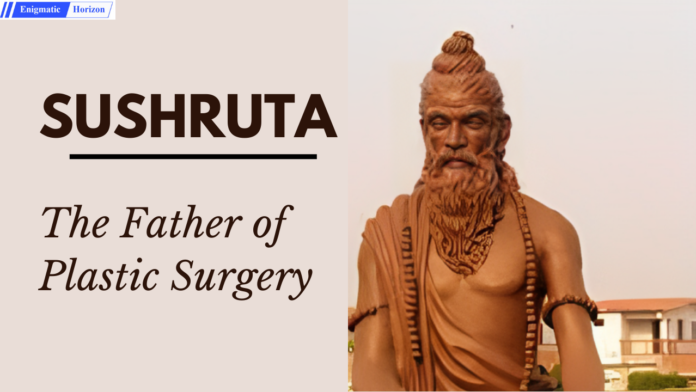Priyal Dholakia
Ancient India was a land of great scientific acumen and aptitude. Many scholars and thinkers made remarkable contributions that shaped various fields of knowledge. Among these luminaries, Sushruta stands tall as the father of Indian plastic surgery.
We will look into Sushruta’s life and accomplishments in this article. We will also discuss his groundbreaking work in plastic surgery and other fields.
Early Life and Education
Sushruta, born in ancient India around 600 BCE, was a skilled surgeon and physician. The specifics of his background are sketchy. But people believe that he was born in Varanasi. Sushruta’s education began at an early age. While still a little child, he had an introduction to the sacred writings and the age-old art of Ayurveda.
Sushruta’s Contributions to Plastic Surgery
Understanding the Art of Rhinoplasty
The development of the rhinoplasty procedure was one of Sushruta’s most significant accomplishments. He devised methods to reconstruct and reshape the human nose. He also laid the foundation for modern plastic surgery. Sushruta’s rhinoplasty approach involved using skin flaps from the forehead or cheek. These were then sculpted and placed on the damaged nose.
Pioneering Reconstructive Surgery Techniques
Sushruta’s prowess extended beyond rhinoplasty. He made groundbreaking advancements in reconstructive surgery as well. Particularly in cases of face malformations induced by trauma or congenital defects. Sushruta’s techniques involved using skin grafts and sutures. He used them to restore the natural form and function of various body parts.
The Sushruta Samhita: A Comprehensive Text on Surgery
Sushruta’s knowledge and expertise were not confined to practical applications alone. He compiled his vast understanding of surgery and medicine into a comprehensive text. Today, we know it as the Sushruta Samhita. This ancient manuscript covers a wide range of surgical procedures. It includes facial surgery, orthopaedics, eye care, and labour and delivery.
Sushruta’s Other Scientific Contributions
Advanced Knowledge of Human Anatomy
Sushruta had a deep understanding of human anatomy and revolutionised plastic surgery. He detailed organs, tissues, and systems, establishing the framework for modern anatomical investigations. Sushruta’s understanding of human anatomy made his surgical procedures precise and more effective.
Development of Surgical Instruments
Sushruta’s expertise in surgery led to the development of many surgical instruments. His innovative instruments facilitated surgical procedures, making them safer and more efficient. He invented and designed various tools, such as scalpels, forceps, and specula. These tools are still used in modern surgical practices.
Contributions to Ayurvedic Medicine
Beyond his remarkable surgical skills, Sushruta was an accomplished Ayurvedic practitioner. Ayurveda is a type of traditional Indian medicine. It emphasises holistic healing and the balance between mind, body, and spirit. Sushruta’s herbal and lifestyle treatments improved disease prevention, diagnosis, and therapy in Ayurveda.
Reviving Ancient Scientific Expertise
Sushruta’s legacy is only a glimpse into the scientific advancements of ancient India. As we advance in science, it is important to look back and recall India’s old scientific knowledge. By honouring the work of experts like Sushruta, we can build a sense of pride in our cultural history. We can inspire future generations to study and improve on this historical wisdom. Hence, it is imperative to revive interest in ancient Indian inventions and discoveries. This will create awareness of the scientific prowess that flourished in our past.
Wrapping up
Sushruta, the father of Indian plastic surgery, transformed surgery with his innovative techniques. But his contributions extended beyond plastic surgery alone. They also encompassed advancements in anatomy, surgical instruments, and Ayurvedic medicine. Sushruta’s accomplishments are a testimony to ancient India’s scientific prowess. Reviving and celebrating this ancient scientific expertise helps us appreciate our great heritage. Apart from this, it can even help inspire a renewed focus on scientific progress.
